Known world from a European perspective around AD 100
Geographical discoveries
978-3-14-100890-6 | Page 28 | Ill. 2

Overview
What would a map of the known world have looked like from a European perspective in 100 AD? Based on historical facts and reports, we can reconstruct today which geographical regions of the Earth were already known in Europe at that time.Ancient trade routes, trade relations preserved in writing, and travel reports can provide conclusions about pre-existing relationships between different regions.
The Roman Empire
The Roman Empire reached its heyday under the rule of the adopted emperors Trajan, Hadrian, Antonius Pius and Marcus Aurelius. It stretched from the Persian Gulf to the Atlantic, from North Africa to Great Britain. It was home to around 100 million inhabitants at that time. The road network covered more than 75,000 km, almost twice the circumference of the Earth. In addition, many other regions of the Earth were known. This can be explained by the Roman Empire's high volume of trade.
Maritime trade
Particularly along the maritime trade routes, Europeans ventured far into areas previously unknown to them. From July to August, they sailed along the Red Sea to the Gulf of Aden. From there, they were able to reach the west coast of India by taking advantage of the north-easterly winds. In February of the following year, they sailed back with the southwest winds. Goods from China were mostly picked up at West Indian ports. Of the small and large empires in India and China, only the economic centres, where the trading partners resided, were known to the Europeans. The interior still remained foreign to them. China's growing economic power and its political-military expansion favoured trade with various regions of Asia. A similar expansion took place in the subtropical regions, where China established a connection to the Indo-Iranian maritime trade via Canton and North Vietnam.
The long-distance trade network
Since the beginning of the imperial period, the long-distance trade network had been constantly expanding. It extended in isolated routes to the Baltic Sea and across the Black Sea as far as Russia. From the east of the empire, caravan routes led through Mesopotamia to the Persian Gulf. Here, it was possible to be part of the long-distance trade with China, South India and Ceylon.
One of the most famous early long-distance trade routes is the Silk Road. It originated around 100 BC, when the Han dynasty protected caravan traffic in a large part of Central Asia. On the 6000-kilometre-long route, Chinese silk, which was highly sought after by the Romans, Roman wool and valuable metals as well as many other high-value luxury goods were transported. Most of the business was transacted via India and Arabia.
Not only merchants, scholars and armies travelled on the Silk Road. Also, technical innovations, religions and entire cultures were transported in both directions on the in both directions.




